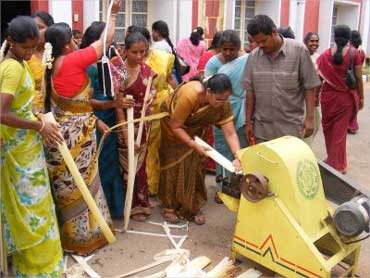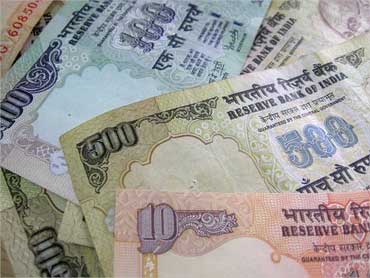Photographs: Courtesy, Eco Green Unit Vikas Bhargavas in Ahmedabad
Gujarat-based Navsari Agriculture University has standardised a process of manufacturing high value paper from banana fibre, which it claims can be used to make currency notes that last for about a century.
"We have standardised the process of making high value paper from banana fibre. The paper has been tested in the Central Institute for Research on Cotton Technology," B N Kolambe, an NAU, said.
"During research it was found that the paper made out of this fibre has shelf life of over 100 years as it is the strongest of the long fibres ever found among the natural fibres. It can be folded as many as 3,000 times," he said.
"This fibre has the potential to find application in making of the paper required for the printing of currency notes," Kolambe said.
"According to references in few leading journals, we found that Japan uses banana fibre to manufacture th paper required to print its currency Yen," he said....
Use as you want, these rupee notes won't tear
Image: A fruit basket made of banana rope.Photographs: Courtesy, ropeinternational.com
Seconding his views, an RBI official said, "Banana fibre as an input raw material could be the secret behind the lasting currency of Japan, whereas the Indian currency is quite prone to getting soiled during transactions and has lower shelf life."
In the present set up, Security Printing and Minting Corporation of India Limited (SPCMIL) imports very high grade quality cotton rags and pulp to manufacture the paper required for currency notes, the official said on condition of anonymity.
"If there is an indigenous alternative available which can reduce the nation's dependence on imports of cotton rags, then the possibility of its introduction should be explored," the RBI official said.
SPCMIL manufactures the paper on which the printing of Indian currency notes takes place and then circulates it among the various secured printing units across the country.
...
Use as you want, these rupee notes won't tear
"The commercial application of banana fibre is viable as its availability is not a constraint. It is generated from the stem of the plant which usually goes as waste and has no other application," Kolambe said.
"We estimate that from one hectare of banana cultivation, about 600 to 800 kilogram of fibre shall be available," he added.The university has filed five different patents from various usage of banana plant, which includes making of yarn for textiles, paper and candy.
The NAU has submitted the findings of its research on banana plant to the National Agriculture Innovation Project (NAIP).
The project was funded by Indian Council of Agriculture Research. NAU was the lead university and CIRCOT, J K Paper Mills, Mantra Textile Institute, Surat were partners in the project with specific roles.




article